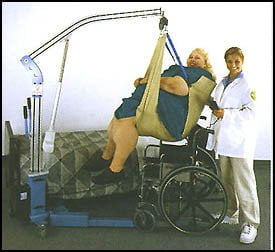 As a home health care provider, quite a few of our clients need help transferring. One of the most common transfer mechanisms is the Hoyer Lift. The Hoyer lift is so frequently used in home health care for transferring that we feel it is important for caregivers and clients both to understand how it works. The Hoyer lift was first developed in the 1950s. The original design is so effective that it has had only minor improvements since then.
As a home health care provider, quite a few of our clients need help transferring. One of the most common transfer mechanisms is the Hoyer Lift. The Hoyer lift is so frequently used in home health care for transferring that we feel it is important for caregivers and clients both to understand how it works. The Hoyer lift was first developed in the 1950s. The original design is so effective that it has had only minor improvements since then.
Below is a picture of the Hoyer Lift that is in our In-Service Training Lab that is used to train our caregivers. The basic Hoyer Lift has a Base with casters that is connected to a Mast with a Boom on top. The Boom has a Cradle connected to it, where a sling that holds the client is connected to the lift. The lift has a hydraulic lever that is used to safely lift the weight of the client.
This is a picture of the Hoyer with the sling on the Cradle.
There are different techniques for transferring a client depending on where the client physically is located. One of the most common transfers in home health care is from the bed to a wheelchair. The first step in a Hoyer bed to wheelchair transfer is to apply the sling to the client. There are different sling designs, but the most popular is called the “U-Sling.” The U-Sling is popular because its design ensures that a client stays in place without the need of a seat belt.
Procedure for a Hoyer bed to wheelchair transfer with the U-Sling:
- Roll the client on their side. Align the sling next to the client with the top portion of the sling toward the head of the client and the bottom at the client’s legs.
- Roll the client on to their back on top of the sling.
- Pull the leg loops under the client inside the thighs and cross the loops. (This is what ensures the client does not slide out of the sling.)
- Roll the base of the Hoyer under the client’s bed, and spread the base open. Spreading the base lowers the center of gravity and makes the transfer safer.
- The cradle should be over the client.
- Connect the loops of the sling to the hooks on the cradle. Again, remember to cross the leg loops.
- Double check all loops, hooks, and positions.
- Slowly raise the client using the lever on the Hoyer until their rear end is just above the bed. The Hoyer will level itself and bring the client into a sitting position.
- Move the client off the bed by using the handles on the Hoyer and rolling them in front of the wheelchair. The client should be positioned facing the Hoyer with their butt over the wheelchair. Make sure the wheels are locked on the wheelchair.
- Slowly lower the client into the sitting position in the wheelchair. Make sure you don’t hit the client with the Cradle of the Hoyer lift.
- Disconnect the sling loops from the hooks on the Cradle.
To transfer the patient from the wheelchair back to the bed, the exact same procedure it done in reverse. As a home health care provider, we feel it is important for both caregiver and client to understand this procedure so both can work together ensuring a safer transfer.


Recent Comments